Landscaping for Wildlife
Develop Your Plan
Plants
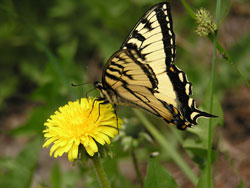 You can attract the greatest variety of wildlife by providing a variety of plants, since different plants provide
different types of food and cover. Remember, it isn’t just the types of plants growing in the area, but how they
are arranged in space that matters. Consider developing a “layered” landscape, using a combination of groundcovers,
flowerbeds, low shrubs, and trees. Arrange your layered plantings in clusters, so that food, water, and cover can be
found close together in several places throughout your area. This will make your landscaping more attractive to wildlife
in general.
You can attract the greatest variety of wildlife by providing a variety of plants, since different plants provide
different types of food and cover. Remember, it isn’t just the types of plants growing in the area, but how they
are arranged in space that matters. Consider developing a “layered” landscape, using a combination of groundcovers,
flowerbeds, low shrubs, and trees. Arrange your layered plantings in clusters, so that food, water, and cover can be
found close together in several places throughout your area. This will make your landscaping more attractive to wildlife
in general.
It is important to realize that your landscape will change over time, and as trees and shrubs continue to grow, their values as food and cover (and shade) will change. Your Landscaping for Wildlife plan should take this change over time into account, and you may wish to imagine your plan unfolding in spans of one, five, ten, and twenty years.
Check out the table in “Native Alaskan and Exotic Plants Used by Wildlife.” As you finalize your landscape design, and begin to choose your plants, remember to select a variety that will provide a range of adequate food sources (such as seeds and berry producing plants) and types of protection (places for nesting and secure areas against predators or bad weather). Finally, think about the appearance of your design and intersperse your plantings with flowers that will bloom at different times throughout the Spring and Summer, as well as plants that provide color throughout the year.
Plants: Values to Wildlife
Coniferous Trees
 Coniferous trees provide food in the form of seeds to Red and White-winged Crossbills, Pine Siskins, Chestnut-backed
and Boreal Chickadees, Pine Grosbeaks beaks, Red-breasted Nuthatches, Red and Northern Flying Squirrels, and a variety
of other species.
Coniferous trees provide food in the form of seeds to Red and White-winged Crossbills, Pine Siskins, Chestnut-backed
and Boreal Chickadees, Pine Grosbeaks beaks, Red-breasted Nuthatches, Red and Northern Flying Squirrels, and a variety
of other species.
Coniferous trees also provide feeding and nesting sites for insect-eating birds, including Ruby-crowned and Golden-crowned Kinglets, Yellow-rumped and Townsend’s Warblers, Varied Thrushes, Gray Jays, and Northern Three-toed Woodpeckers.
Gray Jays and Steller’s Jays also nest in coniferous trees.
Excepting larch, these trees provide excellent winter cover for chickadees, Pine Grosbeaks, Bohemian Waxwings, Dark-eyed Juncos, Boreal Owls, grouse and many others.
Deciduous Trees
Deciduous trees are important feeding sites for Yellow-rumped, Blackpoll, and Orange-crowned Warblers, Black-capped Chickadees, Hermit and Swainson’s Thrushes, American Robins, Common Flickers, and Downy and Hairy Woodpeckers.
Redpolls thrive on birch seeds in winter and spring. Pine Grosbeaks, Ruffed and Blue Grouse, snowshoe hare, and moose feast on the buds, shoots, and twigs of these deciduous tress. During summer, these trees provide valuable cover.
Tall Shrubs
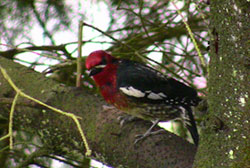 Willow catkins, buds, and twigs are excellent food for Pine Grosbeaks, Ruffed Grouse, Ptarmigan and moose. Wilson’s and Yellow Warblers, Tree Sparrows, and Blackpoll Warblers frequent them for feeding and/or nesting.
Willow catkins, buds, and twigs are excellent food for Pine Grosbeaks, Ruffed Grouse, Ptarmigan and moose. Wilson’s and Yellow Warblers, Tree Sparrows, and Blackpoll Warblers frequent them for feeding and/or nesting.
Maple seeds are eaten by Ruffed Grouse., yellow-bellied Sapsuckers, Red-breasted Nuthatches, Pine Grosbeaks, and Northern Flying Squirrels. Maple also provides excellent cover.
Alder provide food and cover for Savannah Golden-crowned, White-crowned, Tree, Song, and Fox Sparrows; cover for Hermit, Swainson’s and Varied Thrushes, a variety of flycatchers (notable Alder Flycatchers), and is particularly popular with Redpolls. These native plants produce fruits that attract a variety of birds including American Robin, Hermit, Gray-cheeked, and Swainson’s Thrushes, Pine Grosbeaks, Bohemian Waxwings, Common Flicker, and Steller’s Jays.
Black-capped and Boreal Chickadees, Yellow-rumped Warblers and other birds will use these shrubs for cover during summer and fall.
These exotic fruit-producing plants attract some of the same species as the above native Alaskan plants, and these have been shown to be hardy in parts of Alaska. Bohemian Waxwings and Pine Grosbeaks, in particular, seem to be attracted by the berries of these plants.
Lilacs produce fragrant flowers and provide cover for a variety of birds. Lilac seeds are eaten by Pine Grosbeaks. These native plants produce fruits that attract a variety of birds including American Robin, Hermit, Gray-cheeked, and Swainson’s Thrushes, Pine Grosbeaks, Bohemian Waxwings, Common Flicker, and Steller’s Jays.
Low Shrubs
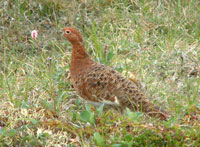 Willow catkins and buds are eaten by Pine Grosbeaks, Ruffed Grouse, Ptarmigan, and moose. Yellow Warblers frequently nest in willows, as do Wilson’s Warblers and Tree Sparrows. Yellow Wagtails, Arctic Warblers, and Redpolls are provided cover and feeding areas by willow patches.
Willow catkins and buds are eaten by Pine Grosbeaks, Ruffed Grouse, Ptarmigan, and moose. Yellow Warblers frequently nest in willows, as do Wilson’s Warblers and Tree Sparrows. Yellow Wagtails, Arctic Warblers, and Redpolls are provided cover and feeding areas by willow patches.
Dwarf birch provides cover and seeds used by Black-capped Chickadees, Redpolls, and a variety of other birds. Rock Ptarmigan and moose eat the buds and twigs.
These berry-bearing low shrubs attract White-crowned Sparrows, American Robins, Pine Grosbeak, Bohemian Waxwings, Black-billed Magpies, Ruffed Grouse, Hermit and Varied Thrush, Steller’s Jay and other species. These birds feed on the berries and use the shrubs for nesting and escape cover. Juniper provides excellent cover for many species as well as berries eaten by Pine Grosbeak, American Robins, Townsend’s Solitaire, and Bohemian Waxwings.
Salal, Labrador Tea, and Bush Cinquefoil provide valuable cover for wildlife. Blue and Spruce Grouse eat Salal, and snowshoe hare browse on Labrador tea.
Lapland Rosebay provides nesting cover for Tree Sparrows, White-crowned, Golden-crowned Sparrows, and produces beautiful pink flowers.
Sweetgale provide food and cover to Yellow-rumped Warblers, chickadees, and other birds.
Ground Cover/Herbaceous Plants
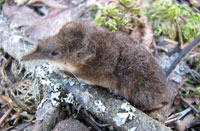 These berry producing ground covers will protect your soil from erosion and provide food for Ruffed, Spruce, and Blue Grouse, Pine Grosbeaks, Tree and Fox Sparrows, American Robins, Common Flickers, Gray-crowned Rosy Finch, and Snow Bunting.
These berry producing ground covers will protect your soil from erosion and provide food for Ruffed, Spruce, and Blue Grouse, Pine Grosbeaks, Tree and Fox Sparrows, American Robins, Common Flickers, Gray-crowned Rosy Finch, and Snow Bunting.
They also provide food for voles and lemmings, and cover for small mammals, shrews, and a variety of ground-feeding and nesting birds. These flowering herbs will add color to your landscaped area and provide seeds eaten by Redpolls, Snow Buntings, Dark-eyed Juncos, Gray-crowned rosy Finches, Tree and White-crowned Sparrows, Ruffed Grouse, and other seed-eating birds.
Mountain Avens and some others also provide food for Snowshoe Hares. All of these provide cover for small, ground-feeding and nesting birds and small mammals.
Problem Wildlife
Remember, Landscaping for Wildlife not only means enhancing the habitat to attract certain species, it may also mean discouraging unwanted, or problem species.
In much of Alaska, this means bears. Keep your family safe and help keep bears wild at the same time, by not attracting bears to your property. Store your garbage responsibly in a closed location off-limits to bears until just before pick up. If you compost, buy or build a bear-proof composter. Some composters have had luck chopping or grinding fruit or vegetable matter so it is less likely to be eaten, and you should never compost animal matter in bear country. Ensure all potential food sources (freezers, barbecues, coolers) are either within fenced areas or are otherwise secured. Avoid putting out bird feeders of any kind during the spring and summer.
If you wish to attract birds, in addition to selecting a variety of “bird-friendly” plants, you can put up nest boxes or birdbaths. Neither attracts bears and will allow you to enjoy birds around your home much of the summer.
Avoid problems with bears and other pests and take your bird feeders down each spring.
Summer bird feeders also attract other critters that may become pests. Red Squirrels are often tempted to nest nearby a nice, well-stocked birdseed feeder. It is not unusual for squirrels to find or chew a way into your attic and set up a nest there, and they are known for chewing on electrical wires in the attic and walls, which can start fires. Woodpeckers can be attracted by suet-feeders and may also decide to nest in your house, which entails drilling one or more large cavities. They also drill in wood siding in search of insects and sometimes will hammer on a loose or resonant board in a territorial or mating display.
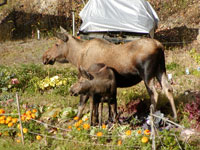 Moose forage largely on the twigs and leaves of certain shrubs (particularly willow), and may be attracted to your yard by the presence of such high quality foodstuffs. If you wish to discourage moose, avoid planting willows or expensive varietal shrubs in unfenced or unprotected areas of your yard. If you wish to attract birds and small mammals, but would like to minimize moose browsing and damage, a list of alternative shrub species and their relative palatability to moose can be found at the end of this webpage. These species are not preferred by moose; however, in winter a moose may be hungry enough to nibble on almost anything.
Moose forage largely on the twigs and leaves of certain shrubs (particularly willow), and may be attracted to your yard by the presence of such high quality foodstuffs. If you wish to discourage moose, avoid planting willows or expensive varietal shrubs in unfenced or unprotected areas of your yard. If you wish to attract birds and small mammals, but would like to minimize moose browsing and damage, a list of alternative shrub species and their relative palatability to moose can be found at the end of this webpage. These species are not preferred by moose; however, in winter a moose may be hungry enough to nibble on almost anything.
Finally, if you live on a lake you may not want to attract Canada geese to your lawn. Canada geese are flightless for about a month and will loiter on lawns eating grass and pooping copiously. If your property fronts a lake, you may wish to consider a landscaping alternative to a short grass lawn, or at least breaking up a large grassy expanse with trees, hedges, and raised beds.
Wildlife Damage to Plants
Occasionally Damaged by Moose
| Common name | Botanical Name |
|---|---|
| Fir | Abies spp. |
| Maple | Acer spp. |
| Serviceberry | Amelanchier sp. |
| Barberry | Berberis spp. |
| Pea Shrub | Caragana spp. |
| Cotoneaster | Cotoneaster spp. |
| Dogwood | Cornus spp. |
| Silverberry | Eleagnus commutata |
| Juniper | Juniperus sp. |
| Norway spruce | Picea abies |
| Colorado Spruce | Picea pungens |
| Pine | Pinus spp. |
| Potentilla | Potentilla fruticosa |
| Mayday | Prunus padus |
| Amur chokecherry | Prunus mackii |
| Currant | Ribes sp. |
| Roses | Rosa sp. |
| Raspberry | Rubus spp. |
| Elderberry | Sambusca spp. |
| Lilac | Syringa spp. |
| Lowbush cranberry | Vaccinium vitis-idaea |
| Viburnum | Viburnum sp. |
Frequently Damaged by Moose
| Common name | Botanical Name |
|---|---|
| Birch | Betula sp. |
| Labrador tea | Ledum sp. |
| Apples, Crab Apples | Malus spp. |
| Quaking aspen | Populus tremuloides |
| Cottonwood | Populus balsamifera |
| Willow | Salix spp. |
| Mountain ash | Sorbus scopulina |
| Highbush cranberry | Vaccinium pauciflorum |
Frequently Damaged by Deer
| Common name | Botanical Name |
|---|---|
| Serviceberry | Amelanchier sp. |
| Maple | Acer spp. |
| Katsura | Cercidiphyllum spp. |
| Apples, Crad Apples | Malus spp. |
| Golden Chain | Laburnum sp. |
| Rhododendron, Azalea | Rhododendron spp. |
| Roses | Rosa sp. |
| Raspberry | Rubus spp. |
| Steeplebush | Spiraea SPP. |
| Lilac | Syringa spp. |
| Blueberry | Vaccinium spp. |
Frequently Damaged by Porcupine
| Common name | Botanical Name |
|---|---|
| Fir | Abies spp. |
| Dogwood | Cornus spp. |
| Hydrangea | Hydrangea spp. |
| Apples, Crad Apples | Malus spp. |
| Spruce | Picea spp. |
| Pine | Pinus spp. |
| Raspberry | Rubus spp. |
| Lilac | Syringa spp. |
